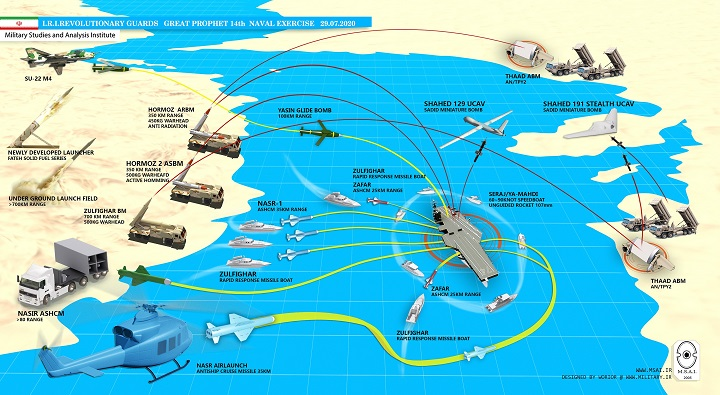July 2020, Islamic republic revolutionary guards performed great prophet 14th military exercise (GP14). In the general area of the Persian Gulf and Hormuz strait, the drill within 2 operational levels conducted. In day 1 a series of surface offensive and aerial defensive tactics carried out with testing newly developed observation and surveillance systems. The main focus in offensive operation was practicing raid against a simulated mockup of the aircraft-carriers, mostly with low range weapons.
For the first time, Fadjr 4CL GPS /INS guided land-attack ballistic missile used against maritime and amphibious targets, as an area denial weapon. The range is still untold, while recently, IRGC released a video that demonstrated aerial launch capability of this missile.
The offensive drill continued by firing more low range Nasr, Nasir, Zafar anti-ship cruise missiles (AShCM) from rapid response missile boats and coastal launchers, and also Nasr-1 air-launch from a helicopter. In following the cruise missile attacks, rocketed speed-boats practicing an incursion and siege toward aircraft carrier with unguided artillery rockets. Subsequently, in the last phase of day 1, IRGC’s Special Force marines carried out an airborne attack inside the carrier.
Day 2, and a significant phase of the exercise started by conducting joint naval, coastal, unmanned aerial surveillance and drone attack operations. This major part of the maneuver carried out by massive firing of precision-guided heavy weapons at longer ranges. Fateh missile family including Khalij-e-Fars (Persian Gulf) and Hormuz missiles launched against predestinated land and sea targets. At the same time, stealth UCAVs like flying wing jet-powered Shahed-191 and propeller-powered Shahed-181, and also Shahed-129 medium-altitude attack drones done their tasked aerial observation and precision bombing operations. Yasin, 500lb glided bomb launched by su22-m4 fighter-bomber and successfully reach its target at 100-kilometer range. The bomb in its last test reached 60km range and further development to a longer range planned.







The point of this part is unveiling newly developed ballistic missile, missile launchers, and underground launch fields. In a released video by IRGC, from the ground with a clear appearance, the planted launchers demonstrating their improvised launch ability from meters below the layer of soil. Launcher tubes are pre-installed and signs of their presence are visually undetectable. And finally, the precise impact on the targets with low CEP is shown. The benefits of these new tactics and underground launch technologies, make it possible to have launch sites everywhere. With low cost and low civil works, uncountable fields could be planted, and while the place is going out of importance, concrete armed missile bunkers are also needless. Thus, in our enemies’ side, the demands and requirements for search and reconnaissance operation and equipment will go high as its costs, the result for IRGC would be a great passive defense at the lowest cost.
There also a different type of launcher unveiled by IRGC, which believed fired solid fuel Dezful missile for the first time. The missile range is about 1000 kilometer. In another interesting footage, a Fateh type ballistic missile precisely targeted a simulated mockup of “AN/TPY 2” radar which currently in use by the THAAD anti-ballistic missile system. These kinds of suppressing enemy air defense operations by using ballistic missiles practiced many times before, and now after the GP14 exercise, these tests proved the unique ability of IRGC’s airspace force and its missileers.
Conclusion for GP-14 is the IRGC forces hardly working in every aspect of close-range naval battle, area denial and anti-access, swarm tactics, and a joint operation with I.R NAVY. These capabilities are essential for the nature of every battle in the Persian Gulf, and to achieving the harmony of force projection, coordinating the multiple levels of strategic arms together, and managing the complexity of grand multi-domain battles.
And we call all of these simply: how to cuts off gunboats from diplomacy.
 Eurasia Press & News
Eurasia Press & News


